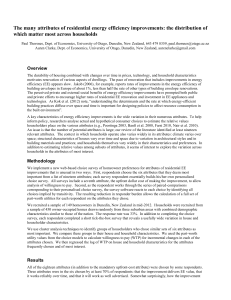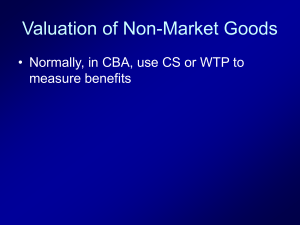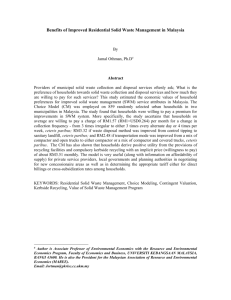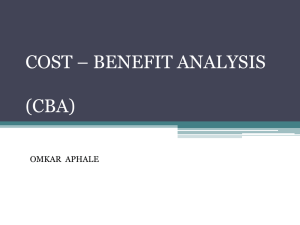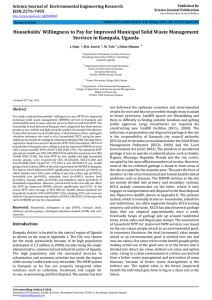Welfare Gains Due to Improved Solid Waste Management
advertisement
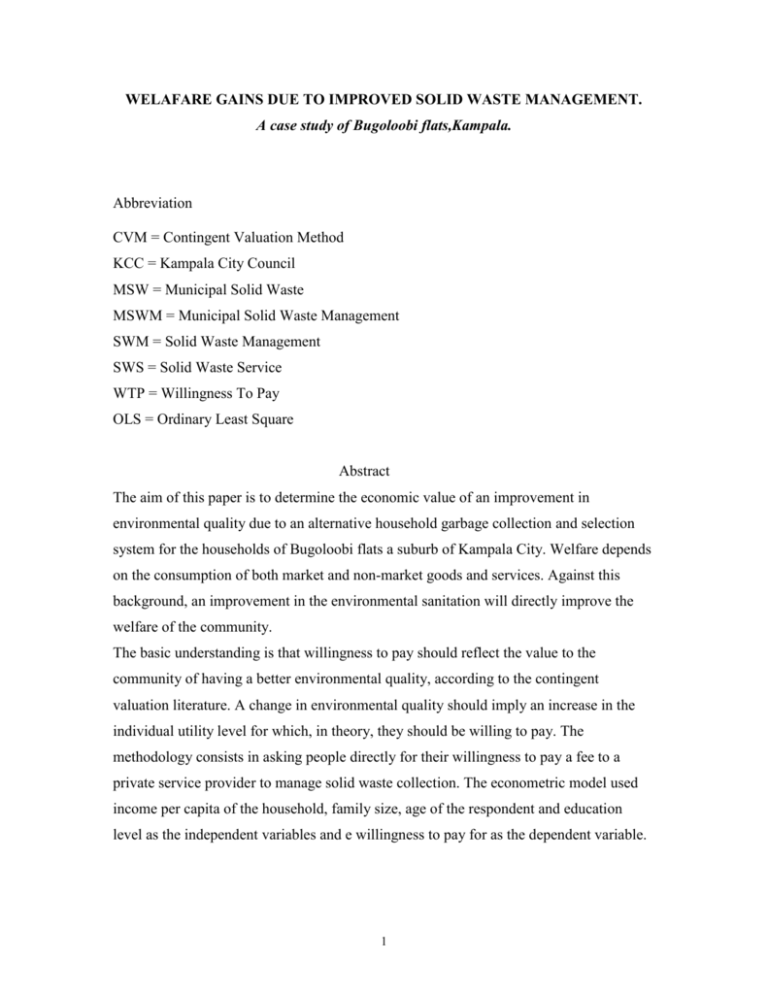
WELAFARE GAINS DUE TO IMPROVED SOLID WASTE MANAGEMENT.
A case study of Bugoloobi flats,Kampala.
Abbreviation
CVM = Contingent Valuation Method
KCC = Kampala City Council
MSW = Municipal Solid Waste
MSWM = Municipal Solid Waste Management
SWM = Solid Waste Management
SWS = Solid Waste Service
WTP = Willingness To Pay
OLS = Ordinary Least Square
Abstract
The aim of this paper is to determine the economic value of an improvement in
environmental quality due to an alternative household garbage collection and selection
system for the households of Bugoloobi flats a suburb of Kampala City. Welfare depends
on the consumption of both market and non-market goods and services. Against this
background, an improvement in the environmental sanitation will directly improve the
welfare of the community.
The basic understanding is that willingness to pay should reflect the value to the
community of having a better environmental quality, according to the contingent
valuation literature. A change in environmental quality should imply an increase in the
individual utility level for which, in theory, they should be willing to pay. The
methodology consists in asking people directly for their willingness to pay a fee to a
private service provider to manage solid waste collection. The econometric model used
income per capita of the household, family size, age of the respondent and education
level as the independent variables and e willingness to pay for as the dependent variable.
1
1.0
Introduction
1.1
Background
Generally, uncontrolled dumping, stock piling and inefficiency characterize Municipal
Solid Waste (MSW) in Kampala. This often times results into water pollution, air
pollution, air and water borne diseases, yet no drastic efforts are directed at necessary
improvements.
In many rapidly growing cities solid waste is a major source of concern owing to weak
authorities, resource constraint and ineffective sanitary management. Solid waste is
supply-driven limited only to local authorities, who are much slower in adjusting to the
demands of the residential areas, industries, institutions and even streets and market
places despite the various charges levied by the city council ().
Solid waste management has a single problem – cost recovery. This is because,
traditionally, solid waste services are financed by general revenues from city taxes and
levies. Consequently, many municipalities in developing countries spend a large
proportion of their budgets on the collection, transport and disposal of solid waste. Their
solid waste management is a costly service that consumes between 20 and 50 percent of
available operational budgets for municipal services, yet serves no more than 70 percent
of the urban inhabitants (Bartone and Bernstein, 1993). Those who do not receive
services are the low-income populations concentrated in the peri-urban areas, who either
do not prioritize the importance of clean environment or are caught in the abyss of
poverty and therefore have more pressing issues. Even those in decent housing areas are
living next to mountains of heaps of garbage lying uncollected. The municipal authorities
have not made sufficient efforts in educating them apart from asking for service charges.
The changing economic trends and rapid urbanization complicate solid waste
management (SWM) in developing countries. Consequently, solid waste is not only
increasing in quantity but also changing in composition from less organic to more paper,
packing waste, plastics, glass, metal wastes among other waste, a fact leading to the low
collection rates (Bartone 1993). In order to cope up with these challenges and because of
2
the critical role in protecting the environment and public health, accomplishing effective
municipal solid be a priority for emerging cities.
However, in the past most attempts to improve solid management in cities have focused
on the technical aspects of different means of collection and disposal (World Bank,
1992). Recently, more attention has been paid to enhancing institutional arrangements for
service delivery, with a special emphasis on privatization (Cointreau, 1994).
In Kampala city and in deed many major towns in Uganda, the standards of solid waste
management (SWM) have always been gauged and evaluated on the role and
performance of service providers such as local authorities and other alternative players.
The policies and legal framework governing SWM have also been directed at these
providers completely ignoring the demand side to the problem. This leaves the solid
waste service providers not fully appreciated by service receivers – households,
institutions, industries and commercial premises. With regard to this, the various players
have directed less effort at investigating the demand side to solid waste management.
This has however, circumvented the proper improvement of the service delivery in the
past. The involvement of the service receivers especially households who are the primary
producers and generators of significant proportion of solid waste, may not only allow
them (households) determine their providers via some arrangements and participate in
making of sound policy decisions including designing of effective joint solutions SWM
but also help the providers to understand households’ willingness to participate, pay and
neighborhood characteristics.
The key question is: What policy recommendations, if any, can be suggested to ensure
efficient delivery of SWS particularly to residential estates.
1.2
Benefits of Efficient SWM
There is a wide range of benefits associated with efficient delivery of solid waste
management services generated by households. However, the benefits hinge, to a large
extent, on the categorization of the wastes into, say, household wastes, medical waste or
industrial waste from factories.
3
Solid waste management benefits accrue to individuals (including households),
production and/ or consumption, to economic assets and environmental assets. This
categorization may also help us dichotomize benefits into health and non-health related
effects. The benefits related to health include the direct health impacts due to reduced
contact of the vulnerable populations with garbage in streets, reckless dumping and
improved management of designated dumpsites. In addition, reduced treatment for illness
such as diarrhea and cholera avert health costs and enhance productivity of the
population.
On the otherhand, non-health benefits resulting from efficient management of solid waste
include a large saving in terms electricity costs in institutions where incineration is used
such as hospitals and industries. Second, prompt solid waste collection reduces private
costs to households associated with garbage disposal for instance purchase of large
garbage containers.
Overall, efficient SWM boosts environmental quality through increased amenity values
such as cleaner air cleaner physical sanitation and increase in non-use value of the
service.
1.3
SWM Status in Kampala.
Kampala is the capital of Uganda with a population of approximately 1.5 million people.
The city is riddled with numerous problems associated with solid waste management.
Waste management is the sole responsibility of the Kampala City Council (KCC) through
the city Environment Department. Waste management constitutes garbage collection and
disposal from households, market areas, hospitals, industries, and city center. Efforts to
manage garbage in the city are continuously overwhelmed and frustrated with the everincreasing population of city residents and levels of economic activity. As result
ineptitudeness and low service coverage characterize KCC. Often times the service are
not on schedule and only provides them in crucial areas such as market places, residential
areas, as well as politically sensitive areas (JICA 1998).
However, in the mid 1970s, KCC collected over 80% of the waste generated in the city.
4
The solid waste services in the city are mainly divided into subsystems- primary and
secondary systems. KCC mainly concentrates on the latter, that is, the secondary system
where it only engages in transportation and disposal of solid waste to the final dumping
site – an open space in the outskirts of the city (Nalukolongo). The primary system,
which is normally at source- households, industries and institutions, are often neglected
despite the KCC levying property and utilities. The council has placed several garbage
pits and containers that are emptied approximately once a week. Eventually heaps of
garbage pile up around the residential areas. The study herein is limited to residential
areas and specifically Bugoloobi flats.
1.4
Alternative Providers
Due to rapid urbanization, high costs of municipal services, gross inefficiency and
resource constraints, KCC is unable to cope with the rapidly expanding demand for solid
waste services. Consequently, various alternative private providers have come in handy
to provide the service more efficiently.
The provision of services by the private groups is going on in Kampala city and in deed
many major towns informally and without the legal sanction of the city council. In fact,
the big for-profit private operators sometimes operate without regulatory framework or
guidance. Unfortunately, they litter the city and devise illegal dumping sites.
In most cases, the private providers are not well prepared and thus unable to cope
especially when KCC denies recognition or does not devise systematic guidelines and
direction. But on rare cases the provision of services by these groups have however, been
approved and regulated by the KCC with regard to areas of operation, kinds of solid
waste handled and manner of disposal. But sometimes these regulations are not
implemented leading to non-compliance hence the private groups.
2.0
Studies on Solid Waste Management
Emerging literature on solid waste management suggest that involvement of
professional collector teams, resident committee workers, private institutions can
prove effective in solid waste management rather than involving only public
5
institutions. Some literature argues that involvement of resident community and
individuals brings about understanding of garbage management which has been a
major source of failure (Olley and Olbina, 1999; Coker and Sikiru,1999;Osucha,
1999).
If people know or are informed about the nature of improvement in environmental
quality, that is, solid waste, the envisaged welfare improvement elicits people’s
WTP.(Hartwick et al 1998).
Households consider solid waste services as normal economic good that can alter
household welfare. But this presupposes the need to understand the existence of a
problem and appreciate the risks they pose before households can make a trade off
decision with regard to WTP (Atlaf et al 1996).
Public cleaning of streets and open area is critically important in areas where waste is
indiscriminately dumped along roadsides and those inefficient collection techniques
may exacerbate this problem (Ohnesorgen 1993). Use of uncovered trucks spill some
of their loads back onto streets and roads thereby complicating the garbage collection
(Ward and Li). Waste collection in developing countries maintained that in such
countries the cost per metric ton of cleaning waste off the streets is estimated to be
between two and three times the cost of collection. He therefore recommended that
covered trucks or other more costly collection equipment that reduce spillage would
probably be more efficient (Cointreau-Levine 1994).
The rural folks expect the municipal cleaning and collection service hence their WTP
is not only low but also negative at times. However, in a study on WTP for
community based solid management and its sustainability in Bangladesh,
Salequzzaman and co-authors (2000) maintain that where a community perceives that
new facilities provide a service higher than the existing management they are more
willing to pay higher contribution. This, according to them, is particularly the case, if
the users are not satisfied with the current service they are receiving. However, this
argument has one major setback because it assumes households have perfect
6
information about the envisaged alternative sanitation methods for them to be
compelled to make higher payments. However, this does not apply to our rural folks,
who may not understand the environmental implication leave alone alternative
sanitation.
The environment is considered to be normal with income elasticity of 0.13 using the
contingent valuation of the environmental impact of SWM in San Pedro CholulaMexico (Viniegra et al, 2001). They also found a negative association between age
and the WTP for quality change of the environment citing the lack of generation
altruism among households.
While investigating management of solid waste in Addis Ababa, (Beyene, 1999)
found that environmental health does not depend on rising public awareness and on
the creation of mechanism of controlling generation of waste at the source. Also,
sharing of responsibilities between the public, institutions, private sector, nongovernmental organizations and the government. The above argument is internally
consistent with Snel (1999) who argued that if responsibilities are shared social
stigma on waste disposal could be mitigated.
In developing countries, the least costly options of waste dumping in public spaces or
burning it openly –are often the most popular (Bartone and Bertntein, 1993). They
argue that although inexpensive in terms of out-of-pocket costs and environment
effects to those that dump or burn waste, these acts may impose large costs on
society. Aesthetic, environmental and health problems may result, especially in
densely populated urban areas.
3.0
Statement of the problem:
A major implication of the pattern of urbanization in developing countries relates to
providing adequate infrastructure. The rapid pace of urbanization would presuppose an
increase in the provision of infrastructure. This has not been the case, as many cities lack
the financial resources and institutional capacity to provide the most basic infrastructure.
7
The problems are likely to become even more pronounced as the level and as the pace of
urbanization continue to grow rapidly.
Due to the overwhelming volumes of solid waste, the Kampala city council can not be
able to satisfactorily collect and dispose. Consequently there has been gradual
degeneration in the management of household waste in residential areas. Service
recipients notably households in Bugoloobi flats have not been given a chance to evaluate
and choose providers of their own or involved in the effective management of solid waste
around their residential area.
Linkages exist between deficient infrastructure and health outcomes of urban residents.
For instance, inadequate provision of proper sanitation account for 7% of all deaths and
diseases worldwide, with children and women being more at risk.
Respiratory infections and diarrheal diseases are the two biggest causes of death among
the poorest 20 percent of the worlds countries ranked by national GDP per capita
(Gwatkin and Guillot 1999).
The solid waste problem has become one of the major concerns for a number of
environmental events. Solid waste management is an important element of public health
and environmental protection: protection against short-term direct and indirect health
risks due to improper waste collection and disposal.
4.1 Privatization
Commonly proposed necessary even though not sufficient solutions include the
contracting of the private sector on the premise that service efficiency and coverage can
be improved, costs lowered and recovered, new ideas, technologies and skills can be
injected (Bartone 1999).
Today's consumers want high-quality services at lower costs. To meet this demand, ways
should be sought to improve operations and make them more cost-efficient. For some,
privatization may offer the best solution to operations efficiency. But before making a
8
decision to privatize operations, public operators must evaluate the impacts that
privatization will have on a facility's overall operations.
In the solid waste industry, municipal landfill operators must consider privatization's
impact on the complete suite of solid waste services that a municipality provides. This
involves evaluating what services a private company will provide and for what fee, as
well as the associated impacts to solid waste customers.
Privatization does have numerous advantages. First, it can increase the pool of staff and
equipment that a municipality can draw upon for various activities. Some municipal
landfill operators realize great financial benefits by turning over their facilities to a
private company that provides more extensive resources. While a private firm may offer
an attractive lower tipping fee, public officials must take into account that the higher
municipal tipping fee may have also funded those other solid waste services typically
demanded by the public, such as garbage recycling and landfill operation (Hauser 2000).
5.0
Objectives of the study
The theory of the measurement of welfare change has been discussed a lot both at
rigorous levels of abstraction and in practical terms of application. Using the already
established tools, this paper therefore proceeds to estimate economic value of welfare
gain with improvement in the SWM. Theoretically changes in SWM can affect
individuals’ welfare through any of the following ways:
Changes in the prices they pay for goods and services bought in markets.
Changes in the prices they receive for their factors of production.
Changes in the quantities or qualities of non marketed goods
And changes in the risk individuals face.
Focus is on measurement of welfare change due changes in the non-marketed service efficient SWM, using the Contingent Valuation method (CVM).
Specific objectives:
To find the mean WTP by households to attain a specified standard of SWM.
To find the determinants of WTP for a specified standard of SWM.
9
6.0
Theoretical Framework and Methodology
6.1
Conceptual Framework
6.1.1
Economic Consumer Theory
The basic approach to the mathematical theories of individual preferences is that of
microeconomic consumer theory (Ben-Arkiva and Lerman, 1985). The objective of the
theory is to provide the means for transformations of assumptions about desires into a
demand function expressing the action of the consumer under given circumstances.
According to this theory, consumer demand as measured by the quantity of the
environmental quality consumed is a function of the prices faced, real income and a set of
consumer characteristics. These consumer characteristics are proxies for his tastes and
preferences.
The consumer is faced with a budget that defines the consumption possibilities, or the
choice set. He therefore has to choose among alternatives the specific goods and services
that best satisfies him and that he can afford to buy given his limited income. The
satisfaction is the utility he derives from the services. The consumer’s goal is there to
maximize utility given his budget constraint. For a fixed income, Y, and vector of prices
p1 and p2.
Pi (X, ) = Y
i=1,2
………………………(1)
Where X= environmental quality
= Other goods and services
P is vector of prices (P = P1, P2)
P1= Price of waste collection.
P2 = Price of other goods.
Y = income of the household.
It is assumed that the household has the ability to compare all the possible alternatives.
10
Thus there exists an ordinal utility function.
U = U (X, )……………………………………………..(2)
This is the household’s preference expressed mathematically. The household’s selection
of the most preferred bundle that satisfies the budget constraint.
Mathematically, utility of a household is maximized subject to the budget constraint.
Maximize U = U (X, )
Subject to
Pi (X, ) = Y
P,Y >0;
6.1.2
Random Utility Theory
The basic problem confronted by discrete choice analysis is the modelling of choice from
a set of mutually exclusive and collectively exhaustive alternatives (Ben-Arkiva and
Lerman, 1985). A decision-maker is modeled as selecting the alternative with the highest
utility among those available at the time choice is made.
It is impossible to specify and estimate a discrete choice model that will always succeed
in predicting the chosen alternatives by all households. We therefore adopt the concept of
Random utility. The true utilities of the alternatives are considered random variables, so
the probability that the alternative is chosen is defined as the probability that it has the
greatest utility among the available alternatives. Though the individual is assumed to
select the alternative with the highest utility, the analyst of random variables does not
know the utilities. From this perspective, the choice probability of alternative k is equal to
the probability that the utility of alternative k, Ukn is greater than all other alternatives in
the choice set.
P(k/Cn) = P(Uin > Ujn) for all j &Cn.
6.2
Contingent Valuation Method (CVM)
11
Contingent Valuation method (CV) is a survey method to elicit consumers’ valuation of
goods and services not sold in the market place, by calculating their Willingness To Pay
(WTP). The method has extensively been used in the valuation of non-market resources
such as recreation, wildlife and environmental quality. In this method, the researcher
creates a hypothetical market in a non-market or new good, invites a group of subjects
(survey respondents or experimental subjects) to operate in that market, and records the
results. The values generated through use of the hypothetical market are treated as
estimates of the hypothetical market.
6.3
Willingness To Pay.
A rational consumer will, due to the constrained maximization facing him, give
preference to alternatives that give him higher utility. A good or service associated with
highest WTP would be the one that yields highest WTP would be the yields utility to the
consumer and vice versa.
Subsequently, a high willingness and ability to pay indicates high utility derived from the
commodity and hence such a good would be given preference, implying its high demand.
Logically, a service that satisfies one most is also highly valued. The value of a service
would be expressed through WTP for the service.
Generally there are two approaches for assessing demand or WTP. The first is the
demand curve approach, which entails making observations on prices and quantities in a
market. A demand curve is estimated and WTP can be inferred. The other approach is the
CVM. This survey-based method uses responses to some questions posed to the
consumer to their preferences and WTP for a hypothetical product or service. This is the
method in this study since environmental quality is not available in the market.
According to theory, if demand for this service exists, then this must be reflected by
WTP. A high WTP is logically a proxy for its demand. Thus the value placed by a
consumer on a service can be expressed as WTP to obtain it.
An appropriate approach is to directly ask households or individuals to state their
willingness to pay for improved solid waste management using the survey techniques.
Despite the arguments that strategic bias will invalidate survey results, the survey
12
technique is most relevant to this study. Also results of using the survey approach for
estimating the value of public goods or services are internally consistent, replicable and
consistent with demand theory.
This method has the chief advantage in that it considerably reduces strategic bias (Arrow
et al, 1993). Strategic bias arises when respondent attempts to influence the results of a
WTP survey by answering in such a way as to serve his own interest rather than reveal
his true valuation of the good or service. For instance, the respondent might give very
low amount of WTP if felt that the answer would influence by lowering the amount he
would be charged for the improved SWM.
Econometric Model
Double-Bounded Logit Model
Assume there be N survey respondents. Respondent I is offered an initial bid amount Bi
and one of the follow-up bids (Bi d , Bi u), where id i iu . if di is a binary indicator
variable for the yes-no response probabilities. The probability of a represent say yes to
the initial bid value offered (i).
Pi y prob( yes )
Then we consider the double-bounded format, where each participant is present with two
sequential bid values and the second bid value is conditional on the first bid value.
Following Hanemann et al (1991), the response probabilities are:
yy 1 G ( Biu ; )
nn G ( Bid ; )
iyn G ( Biu ; ) G ( Bi )
iny G ( Bi ; ) G ( Bid ; )
G will be represented by the cumulative logistic function
) (pxe
) ;B ( G
) (pxe 1
where B
13
the log-likelihood function for the double-bounded model, parameterized
by
n
ln LD ( ) {d iyy ln yy ( Bi , Biu ; ) d inn ln nn ( Bi , Bid ; ) d iyn ln yn ( Bi , Biu ; ) d iny ln ny ( Bi , Bid ; )}
i 1
The ML estimator for the double-bounded model , is the solution to the equation
ln LD ( ) / 0
Measuring Goodness of Fit
Goodness-of-fit measures are used to assess how well an econometric model explains the
observed data or how well fitted values of the response variable compare to the actual
values. There are several options for measuring goodness of fit when using binary
discrete choice data: the McFadden pseudo R2, the Pearson chi-square test, and the
classification procedure.
McFadden Pseudo R2
A popular goodness-of-fit measure for binary discrete response data is the McFadden
pseudo R2, which is written as
R2 = 1 – L0/Lmax
The above model is used to estimate the predict model
Analytical Model
From past studies, WTP of individuals is related to income level of households, socioeconomic and demographic factors. Studies by Knetsch and Davis (1966), and
Whittington (1993) in particular single out such factors as the cost of obtaining the
evironmental good or service, educational level, age of the respondent, family size,
religion, marital status among others, explain the variations in respondent’s WTP for
environmental goods/services.
14
WTPi = f(Y, FS, Educ, Age, ES, Di )
WTPi = willingness to pay for efficient SWM.
WTP/Y>0; WTP/FS><0; WTP/Educ>0 WTP/Age>0
(1)
On the basis of theoretical exposition and data we specified two models. First, a
multiplicative model (3) that assumes constant differential effects among the variables
and second, one that takes into account interaction among variables (2).
WTPi = 0(Ypc) 1(FS) 2(Educ) 3(Age) 4(ES) 5Dii
(2)
WTPi = willingness to pay for improved solid waste management by household i
Ypc = Per capita income (monthly household income divided by the family by the
household size)
FS = Family Size
Age = Age of the respondent
Educ = Education level of the respondent
Di = a vector of dummy variables
Dummies;
ee = Environmental Ethics
gnd = gender
ms = Marital Status.
Logarithms are introduced on both sides of the above to make the log-log equations
below. This was basically done because of two reasons. First, it was dictated by the data
and secondly because of the need to capture elasticity of WTP for improvement in solid
waste management in Bugoloobi flats with respect to household income, increases in
years of schooling, increases in family size and age of the respondents among other
variables.
15
lnwtpi = 0 + 1lnYpc + 2FS + 3Educ + 4Age + ln
(3)
D-optimal Design for the Double-Bounded.
The choice a particular bid design affects the efficiency of the survey experience. In both
single and double-bounded model, (Kanninen 1993) shows that the D-optimal bid designs
is superior to the c-optimal and Fiducial method design and hence its choice.
In the double-bounded case, there are three bid amounts specified for each observation.
Although each person is asked only two bids, all three bids enter the log-likelihood
function apriori, it is not known which response any household will give to the initial bid.
The D-optimal design utilize a number of restrictions to avoid solving simultaneous
problem. According to this design, the initial bid is the median value which given by
expression -/.
Expected Results
Assessment of the prevailing SWM situation in Bugoloobi flats indicates that KCC is
inefficient due to large diseconomies of scale. As highlighted in chapter 1, it is expected
that private service providers are somewhat relatively efficient and offer quality service
as opposed to the KCC.
This means that generally, are willing to pay more than what they are currently incurring
in SWM.
A positive WTP implies that households demand SWM in which the improvement in the
solid waste management will directly improve their welfare also.
The analytical model is likely to generate a positive coefficient for the per capita income
of households. Theoretically, a low-income household is willing to pay less than tha
higher income household. This is as incomes increase, households tend to have more
“discretionary income “ and hence more scope of choice about the disposition is a
luxurious good.
16
On the hand, it is expected the coefficient of the environment ethics dummy will be
negative. Households that take sanitational precaution such as proper solid waste disposal
are less willing to pay for the service via this arrangement. This can supported by the
following hypotheses;
Many households may not want to participate in communal arrangements.
Others cannot afford the services or are simply acting strategically or exhibiting free
riding behavior. From previous studies carried out elsewhere the factors envisaged in the
analytical model may as well significant in the determination of the WTP in Bugoloobi
flats.
References
Arrow, K., Solow, R., Leamer, E., Portney, P., Radner, R. and Schuman, H. 1993. Report
on the NOAA Panel on Contingent Valuation. Federal Register, 58:10. Department of
Commerce, USA.
Bartone, C.L., Luiz, L., Thelma, T & Schetenleis (1991). “Private Sector Participation in
Municipal Solid waste services: Experiences in Latin America” Waste Management
&Research 9:495-509.
Bartone, C.L & Bernstein, J.D (1993). “ Improving Municipal Solid Waste Management
in Third World Countries". Resources, Conservation and Recycling; 8; 43-45.
Baud, I.S.A. (2000) Collective Action, Enablement and Partnerships: Issues in Urban
Development; Amsterdam.
Ben-Arkiva, M. and Lerman, S.R 1985. Discrete Choice analysis: theory and application
to travel demand. Cambridge, Massachusetts: MIT Press.
17
Bishop, R.C and Heberlein, T.A. 1990. The contingent valuation method. In Economic
Evaluation of National resources: issues, theory and applications, eds. R.L Johnson and
G.V Johnson. West view Press, Boulder, CO, pp. 81-104.
Boadway, R.W (1975) “Cost-Benefit Rules in General Equilibrium.” Review of
Economic studies, 42, 361 – 73.
Boadway, R.W and Bruce N (1984) “Welfare Economics.” Basil Blackwell, Oxford.
Freeman Myrick A (193) “The Measurement of Environment and Resources Values;
Theory and Methods.” Resource for the future, Washington D.C.
Fullerton, Don & T.C. Kinnamon (1993). “Garbage Recycling and Illicit Burning or
Dumping, National Bureau of Economic Research (NBER), Cambridge.
Gravelle, H. and R. Ress (1992) “Microeconomics.” Longman.
Gwartkin, D.R., and M. Guillot. 1999. “The Burden of Diseases Among the Global Poor:
Current Situation, Future Trends and Implications for strategy.” Global Forum on Health
Research Working Paper. July
Hanemann (1994): “Valuing the Environment Through Contingent Valuation”; Journal of
Economic perspectives 8(4): 19-43.
Hanley N and Spash C.L (1993). Cost-Benefits analysis and the Environment. London
Edward Elgar.
Johansson Per-Olov (1987) “the economic Theory and Measurement of Environmental
Benefits.” Cambridge University Press.
18
Mitchell R.C 4 Carson R.T (1989). “Using surveys to Value goods/service: The
Contingent Valuation Method.” Washington DC, Resources for the future.
Ohnesorgen, F (1993): sorting out solid waste: Developing Countries Need Management
Expertise.” Public Management, 75; 9-12.
Olley, J and Olbina R. (1999) “Innovative solid waste management in China” in Pickford
John (1999) integrated development for water and sanitation, 25th WEDC conference.
Osuocha, C.P (1999). Improving refuse management in urban Nigeria, in Pickford John
(1999) integrated development for water and sanitation.
Salequzzaman M.D, Sqadiqul A, Mostafa A (2000): “Willingness-to-pay for communitybased.Solid Waste Management and its sustainability in Bangladesh; Research institute
for Sustainabilty and Technology Policy, Murdoch University, Austraulia.
Snel M (1999). Social Stigma and the waste collection scheme, in Pickford John (1999)
integrated development for water and sanitation, 25th WEDC conference.
Viniegra, M.E., T.T Cortes and E.M Cuevas (2001) “Economic Valuation of
Environment Impact of Solid Waste Management”; university de la America, Puebla.
Whittington, D., Laura, D.T., Wrght, A.M., Choe, K., Hughes, J.A and swarna, V.,
(1992): “Household Demand for Improved sanitation Services in Kumasi, Ghana: A
Contingent Valuation Study.” Water Resources and Research, Vol.29 (6) 1539-156
Whittington, D., Laura, D.T., Wrght, A.M., Choe, K., Hughes, J.A and swarna, V.,
(1992): “Household Demand for Improved sanitation Services in Kumasi, Ghana: A
Contingent Valuation Study.” Water Resources and Research, Vol.29 (6) 1539-1560.
19
Whittington, D., Lauria, D.T., Wrght, A.M Choe, K., Hughes, J.A., and Swarna, V.,
(1993): “Household Sanitation in Kumasi Ghana-A Description of current practices,
attitudes and Perceptions, World Development report 1992.
Whittington, D., Pearce, D.W & Moran, D. (1993) Economic values and the Environment
in the developing World: A Report Prepared for United Nations Environment
Programme, Nairobi, Kenya.
World Bank (1992) World Development Report “ Development and Environment New
York.
Appendices
The CVM question put to the households
Currently the SW is managed by the KCC and as it is, garbage is collected once in two
weeks. The garbage that piles up during that period attracts a lot of houseflies.
Furthermore, the waste pits are near the children’s playgroup, which exposes them to
health hazards. As a result households incur health costs to treat family members.
Besides the sight of stockpiles near the residences is unpleasant.
Therefore, if SW is managed a private firm so that garbage is collected every three days,
are you willing to pay Ushs……. Per month for your household to participate in the solid
waste management program?
1.Yes
2.No
This is a dichotomous choice format, which gives the respondents specific amounts and
asks them whether they are willing to pay that amount or not. The respondent answers
with a “no” or a “yes”. The yes-no answers are then used along with the required
payment to estimate a discreet model from which expected WTP is calculated.
20
21
